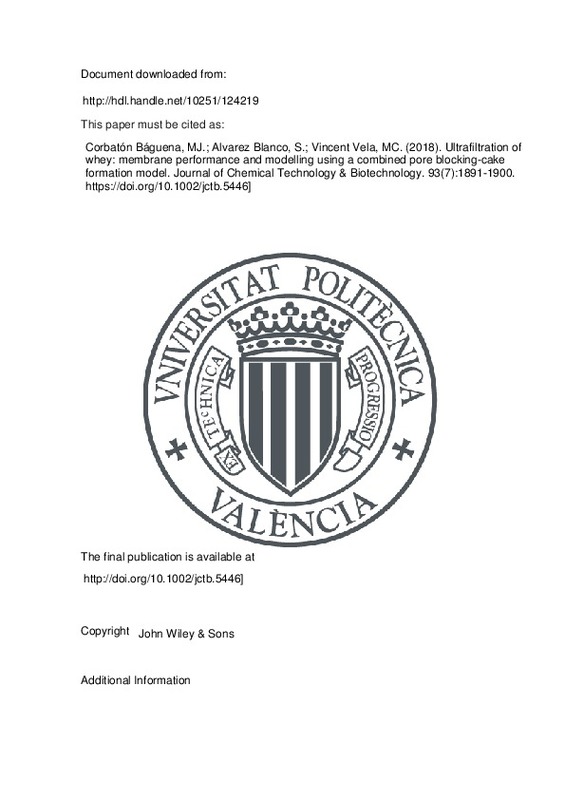JavaScript is disabled for your browser. Some features of this site may not work without it.
Buscar en RiuNet
Listar
Mi cuenta
Estadísticas
Ayuda RiuNet
Admin. UPV
Ultrafiltration of whey: membrane performance and modelling using a combined pore blocking-cake formation model
Mostrar el registro sencillo del ítem
Ficheros en el ítem
| dc.contributor.author | Corbatón Báguena, María José
|
es_ES |
| dc.contributor.author | Alvarez Blanco, Silvia
|
es_ES |
| dc.contributor.author | Vincent Vela, Maria Cinta
|
es_ES |
| dc.date.accessioned | 2019-07-25T20:01:14Z | |
| dc.date.available | 2019-07-25T20:01:14Z | |
| dc.date.issued | 2018 | es_ES |
| dc.identifier.issn | 0268-2575 | es_ES |
| dc.identifier.uri | http://hdl.handle.net/10251/124219 | |
| dc.description.abstract | [EN] BACKGROUNDUltrafiltration has been considered as a green' technique to treat different industrial wastewaters, such as whey in the dairy industry. However, fouling is one of the major drawbacks in the industrial implementation of this process. Thus, in this work, the performance of ultrafiltration membranes was investigated in terms of permeate flux and protein rejection when treating different whey model solutions. Modelling of permeate flux was performed combining two main fouling mechanisms (complete pore blocking and cake formation) by a time-dependent pore blocking parameter. RESULTSResults demonstrated that high protein concentration and the presence of calcium salts in the feed solution favoured permeate flux decline. The combined model was appropriate to describe the main fouling mechanisms, with fitting accuracies higher than 0.960. Model parameters were correlated with both calcium and protein concentration and the developed model was successfully validated with an additional fouling test. CONCLUSIONAll the membranes tested were suitable for carrying out whey protein separation, with rejection indexes greater than 99%. The combined model and the statistical correlation of model parameters with calcium and protein concentrations were useful to predict permeate flux decline when the ultrafiltration of a new whey model solution was performed. (c) 2017 Society of Chemical Industry | es_ES |
| dc.description.sponsorship | This work was supported by the Spanish Ministry of Science and Innovation (project CTM2010-20186). | |
| dc.language | Inglés | es_ES |
| dc.publisher | John Wiley & Sons | es_ES |
| dc.relation.ispartof | Journal of Chemical Technology & Biotechnology | es_ES |
| dc.rights | Reserva de todos los derechos | es_ES |
| dc.subject | Ultrafiltration | es_ES |
| dc.subject | Whey model solutions | es_ES |
| dc.subject | Membrane fouling | es_ES |
| dc.subject | Fouling mechanisms | es_ES |
| dc.subject | Complete pore blocking parameter | es_ES |
| dc.subject.classification | INGENIERIA QUIMICA | es_ES |
| dc.title | Ultrafiltration of whey: membrane performance and modelling using a combined pore blocking-cake formation model | es_ES |
| dc.type | Artículo | es_ES |
| dc.identifier.doi | 10.1002/jctb.5446] | es_ES |
| dc.relation.projectID | info:eu-repo/grantAgreement/MICINN//CTM2010-20186/ES/TECNICAS NO CONVENCIONALES PARA LA LIMPIEZA DE MEMBRANAS DE ULTRAFILTRACION APLICADAS EN LA INDUSTRIA ALIMENTARIA/ | es_ES |
| dc.rights.accessRights | Abierto | es_ES |
| dc.contributor.affiliation | Universitat Politècnica de València. Departamento de Ingeniería Química y Nuclear - Departament d'Enginyeria Química i Nuclear | es_ES |
| dc.description.bibliographicCitation | Corbatón Báguena, MJ.; Alvarez Blanco, S.; Vincent Vela, MC. (2018). Ultrafiltration of whey: membrane performance and modelling using a combined pore blocking-cake formation model. Journal of Chemical Technology & Biotechnology. 93(7):1891-1900. https://doi.org/10.1002/jctb.5446] | es_ES |
| dc.description.accrualMethod | S | es_ES |
| dc.relation.publisherversion | http://doi.org/10.1002/jctb.5446] | es_ES |
| dc.description.upvformatpinicio | 1891 | es_ES |
| dc.description.upvformatpfin | 1900 | es_ES |
| dc.type.version | info:eu-repo/semantics/publishedVersion | es_ES |
| dc.description.volume | 93 | es_ES |
| dc.description.issue | 7 | es_ES |
| dc.relation.pasarela | S\346723 | es_ES |
| dc.contributor.funder | Ministerio de Ciencia e Innovación | es_ES |







![[Cerrado]](/themes/UPV/images/candado.png)

